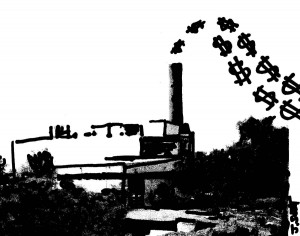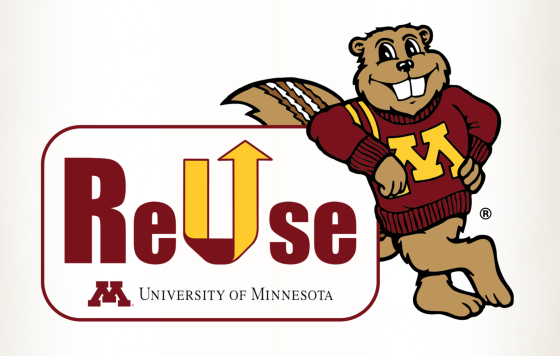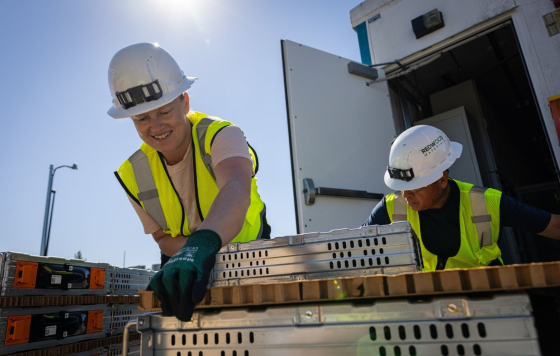
Today, just two months after local governments' Fiscal Year 2026 budgets were passed, the Baltimore City Planning Commission kicks off the planning process for the Fiscal Years 2027-2032 Capital Budget. So, we're starting now to advocate for capital infrastructure spending on Zero Waste infrastructure that Baltimore City needs to equitably and cost-effectively transition away from trash incineration. Read our comments below, and send a message to the Mayor and City Council today!
Thursday, August 28, 2025
Comments on the FY27-32 Capital Improvement Program Kickoff
Dear members of the Planning Commission and staff of the Department of Planning,
South Baltimore Community Land Trust and Clean Water Action urge you to prioritize key investments in Zero Waste infrastructure in the upcoming six-year capital improvement plan to ensure that Baltimore can equitably and cost-effectively transition away from incinerating its trash by 2032. Given the looming end of the City’s current contract to send waste to the incinerator in 2031, these investments are urgent and necessary to avoid more expensive unplanned costs and difficult choices in the future.
Elected officials across City government have consistently expressed support for making this transition. When then-Mayor Young signed the City’s current contract to send waste to the BRESCO incinerator in 2020, then-Council President Scott pledged, “Under my administration, we’re going to work to not burn as much at the incinerator as possible... And I will work my butt off to make sure that this is the last time we ever give them a new contract.” Upon taking office, Mayor Scott promised that his administration would “Reduce chronic health disparities across racial and ethnic groups by decommissioning the use of waste incineration within the next decade” in his First Term Action Plan. Earlier this year, Mayor Scott, Comptroller Henry, and the entire City Council showed support for the Reclaim Renewable Energy Act, important state legislation to end Maryland’s unfortunate practice of classifying and subsidizing trash incineration as “renewable energy;” with the City’s support, this policy was adopted into law in April.
However, the financial investments the City must make in infrastructure to build this transition have lagged behind. As detailed below, the only Zero Waste infrastructure project that the City has invested capital funds into has been a $5 million investment in FY24’s capital budget plan in a future compost facility to be built on Bowley’s Lane ($4 million of which came from a federal grant). This facility is currently funded to be built at a capacity of 12,000 tons/year, which is only about 15% of the compost processing capacity that the Less Waste Better Baltimore Master Plan (LWBB), adopted in 2020, projects the City ultimately needs. Investments in improved recycling facilities and a facility to manage construction and demolition materials, also key infrastructure components of transitioning away from the trash incinerator, have been requested by DPW but have been reduced, delayed, or denied in the capital budget in FY24 and FY25. In FY26, DPW did not even request funding in the six-year capital budget program for any of these projects. Comptroller Henry and Council President Cohen abstained from voting on the budget at the Board of Estimates on May 7, with Comptroller Henry specifically stating that “the FY2026 budget as it is before us does not invest nearly enough in … Zero Waste initiatives that DPW has been promising for years – and requested be included – but were left out of the version before us today.”
The Planning Commission prioritizing these investments in the upcoming six-year capital improvement plan is necessary for equity and environmental justice. In May 2024, South Baltimore Community Land Trust filed a Title VI complaint under the federal Civil Rights Act over the City’s 10-Year Solid Waste Management Plan, citing that “the City’s lack of urgency and apparent disinterest in meaningfully advancing diversion practices evidences an intent to continue allowing communities in the Impacted Area to bear the burden of BRESCO’s operation.” This complaint outlines the environmental injustices of burning waste and polluting City neighborhoods, and demands practical remedies in City finances, investments, and policies. The EPA has granted the complaint, though it has not resolved the matter. And since the complaint was filed in 2024, the City’s six-year capital budget plans have only delayed and reduced planned spending on Zero Waste infrastructure each year. These delays and reductions have very real consequences: new research this year demonstrates how emissions from the BRESCO trash incinerator cause $53.8 million worth of health damages every year.
The FY27-32 Capital Improvement Program is Baltimore’s plan for spending on capital infrastructure through June 30, 2032 - past the end of the City’s current contract to send its waste to the BRESCO incinerator on December 31, 2031. This six-year plan must lay out the serious infrastructure investments necessary to put Baltimore on a course to prevent, reduce, compost, and recycle meaningful portions of its waste by FY2032: investments that will reduce local air pollution and greenhouse gas emissions, improve water quality, and create good local jobs. In contrast to the investments needed in Zero Waste infrastructure, the City projects that the cost of expanding the Quarantine Road Landfill will total $108,346,000 (FY26-31 Capital Improvement Program Report: Planning Commission Recommendations, page 194), and DPW staff informed the Council at the 4/30/2025 oversight hearing that this is only expected to extend the life of the landfill by 10 years. If Baltimore City does not make these investments now, the City’s future leaders in 2031 will face much more expensive and difficult choices in order to keep promises to make the City’s current contract to burn waste at the BRESCO incinerator its last.
Please prioritize investments in these key Zero Waste infrastructure projects in the FY27-32 Capital Improvement Program.
Compost facilities
That city’s plans propose a phased-in, decentralized approach to building 20,000 ton/year compost facilities throughout the city sequentially to meet growing demand for compost processing capacity. Less Waste Better Baltimore estimates Baltimore’s Maximum Diversion Potential (goal for diversion from disposal at the landfill or incinerator to composting) for organic waste at 78,300 tons per year.
Currently, the City has only planned financing to construct 12,000 tons/year of compost capacity through FY31. This facility was funded in FY24 through $1 million of City GO Bonds with a $4 million EPA grant awarded in September 2023. In FY24’s planning stages, DPW requested $8 million in GO Bond funding for the construction of compost facilities between FY26-FY29. After the City received the EPA grant, the Planning Commission reduced and delayed this City investment in the FY24 capital budget plan. In FY25 and FY26, those planned investments were eliminated, and there is no funding planned to increase the City’s compost capacity through FY31.
| FY24 | FY25 | FY26 | FY27 | FY28 | FY29 | FY30 | FY31 | |
| FY24 requested FY24 awarded | $0 $5 million * | $0 $0 | $2 million $0 | $2 million $0 | $2 million $1 million | $2 million $2 million | - | - |
| FY25 requested FY25 awarded | - | $0 $0 | $0 $0 | $0 $0 | $0 $0 | $0 $0 | $0 $0 | - |
| FY26 requested FY27 awarded | - | - | $0 $0 | $0 $0 | $0 $0 | $0 $0 | $0 $0 | $0 $0 |
* $4 million in federal funds from an EPA grant, $1 million City match with GO bonds.
This compost facility will be located at the future Eastside Transfer Station at Bowley’s Lane, and the $21 million in GO Bond funding allocated for the transfer station in FY26 will complement the colocated compost facility. However, DPW staff confirmed at the Zero Waste oversight hearing on 4/30/2025 that the capacity of the compost facility once built (12,000 tons/year, 50% site capacity) will be no higher than the capacity already funded in FY24. Despite significant interest among residents and institutions in the City for food scrap collection, DPW has only planned for this facility at its currently-funded capacity to accept yard waste, projecting an expansion to also process food scraps for a future expansion to bring the facility to its planned full capacity (24,000 tons/year).
LWBB calls for building multiple such facilities throughout the City to compost the city’s yard waste and food scraps, but only one-half of one facility is currently projected to be built through the end of the current contract with BRESCO. Without additional capital funding for compost facilities in FY27-FY31, the City will have only built 12,000 tons/year of composting capacity by the end of the current contract with BRESCO - far short of the 78,300 tons/year of capacity needed.
Recycling facilities
Less Waste Better Baltimore projects a Maximum Diversion Potential of 153,500 tons/year from improved and expanded recycling collection. The 10-Year Solid Waste Management Plan proposes constructing small-scale Materials Recovery Facilities (recycling plants) to reduce transportation costs and reliance on out-of-city vendors. It projected that design, permitting, and construction would take three years, and a new MRF could become operational as soon as 2029. (pages 184-186)
In FY24, DPW requested $10 million between FY28-FY29 for this project, but the Planning Commission denied that request. No funding has been requested or awarded for these facilities in FY25 or FY26, leaving no investment planned through the end of the current BRESCO contract in 2031.
| FY24 | FY25 | FY26 | FY27 | FY28 | FY29 | FY30 | FY31 | |
| FY24 requested FY24 awarded | $0 $0 | $0 $0 | $0 $0 | $0 $0 | $5 million $0 | $5 million $0 | - | - |
| FY25 requested FY25 awarded | - | $0 $0 | $0 $0 | $0 $0 | $0 $0 | $0 $0 | $0 $0 | - |
| FY26 requested FY27 awarded | - | - | $0 $0 | $0 $0 | $0 $0 | $0 $0 | $0 $0 | $0 $0 |
Construction and Demolition materials facility
Less Waste Better Baltimore projects a Maximum Diversion Potential of 228,500 tons/year from reusing, reducing, and diverting construction and demolition materials. In FY24, DPW requested $20 million between FY25-FY29 for a facility to better manage construction and demolition materials, but the Planning Commission reduced and delayed that funding to $2.75 million across FY27-29. In FY25, DPW requested $5 million across FY28-FY30, and the Planning Commission actually increased that funding to $12 million. However, in FY26, DPW did not request any funding and the Planning Commission did not award any.
| FY24 | FY25 | FY26 | FY27 | FY28 | FY29 | FY30 | FY31 | |
| FY24 requested FY24 awarded | $0 $0 | $5 million $0 | $5 million $0 | $5 million $1 million | $5 million $0.75 million | $5 million $1 | - | - |
| FY25 requested FY25 awarded | - | $0 $0 | $0 $0 | $0 $0.5 million | $1 $3.5 million | $2 million $4 million | $2 million $4 million | - |
| FY26 requested FY27 awarded | - | - | $0 $0 | $0 $0 | $0 $0 | $0 $0 | $0 $0 | $0 $0 |
Explaining this lack of FY26 investment, staff labeled it a “Priority Change” and said “Prioritizing compliance and safety projects” (FY2026-2031 Agency Requests vs. FY2025-2030 BOE Recommendations, page 16). These two investments must not be pitted against each other - both are necessary for the City to create an equitable and effective solid waste management system.
Conclusion
As members of the Planning Commission and staff at the Department of Planning, please encourage the Department of Public Works to make robust, meaningful capital budget requests for Zero Waste infrastructure investments, and please ensure these remain priorities throughout the planning period of the FY27-32 Capital Improvement Program. These infrastructure investments are necessary to ensure that Baltimore can actually implement an equitable and cost-effective transition away from trash incineration by the end of the City’s current contract with the incinerator in 2031.


